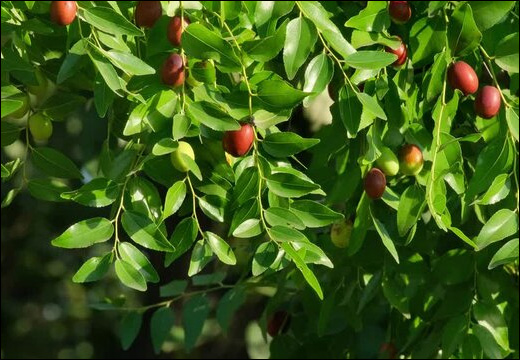Zizyphus Vulgaris / Zizyphus Jujuba / Zizyphus Nummularia – Uses, Benefits, Dosage & Properties
Abstract
Traditional medicines are used by nearly 60 percent of the world’s population. These are not only used for primary health care in rural areas but also in developing countries. In developed countries, modern medicines are predominantly used. Zizyphus species, commonly known as jujube or ber, are ancient medicinal plants with roots in Ayurveda. Among them, Zizyphus vulgaris, Zizyphus jujuba and Zizyphus nummularia hold a special place due to their potent health benefits. This species is widely used in the management of wounds, low appetite, skin problems, bleeding disorders and many more health problems. This article explores their botanical identity, therapeutic properties, uses in Ayurvedic medicine and modern scientific relevance.

Introduction
Zizyphus species are categorised under Amradiphala Varga in Bhavprakash Nighantu. It is commonly known as Ber. Beyond their medicinal value, these fruits hold a sacred place in Indian culture and spiritual tradition. One of the most beloved references to the jujube fruit comes from the Ramayana, where an elderly devotee named Shabari offered the ber fruits to Lord Sri Rama. In her deep devotion, she lovingly tasted each fruit before offering it, wanting only the sweetest ones to reach her Lord. Far from being offended, Lord Rama, touched by her pure bhakti (devotion), accepted the half-eaten fruits with immense love and grace. This story symbolises how sincere devotion transcends formality and how nature’s simple offerings, when given with love, are most dear to the Divine. Further, let’s discuss the whole description of this herb and its types, along with their properties.
Varieties Of Zizyphus Species
The Zizyphus genus includes various species, many of which are used in traditional systems of medicine like Ayurveda, Unani and Traditional Chinese Medicine. Below are some of the most notable varieties:
1. Zizyphus Vulgaris
Zizyphus Vulgaris is a spiny shrub or small tree belonging to the Rhamnaceae family. It is widely recognised for its nutritive and medicinal properties in both traditional and modern herbal systems, including Ayurveda, Unani and Traditional Chinese Medicine.
Scientific Classification
- Kingdom: Plantae
- Division: Magnoliophyta
- Class: Magnoliopsida
- Order: Rosales
- Family: Rhamnaceae
- Genus: Zizyphus
- Species: vulgaris
Synonyms
- Unnava
- Souvir
- Rajbadara
Habitat
It is found in Punjab, the Himalayas up to 2170 meters, Bengal in the east, North West Frontier Province and Baluchistan. It is mostly found in countries like China, Iran, etc.
Morphology
This shrub is small and thorny. Leaves are oval and flowers are greenish white. Fruits are red, wrinkled, 2.5-3 cm long, 2.5 cm wide and similar to Ber fruit. The pulp of which is sticky, sweet, yellow and light. Kernels are long, hard and wrinkled.
Classical Categorisation
- In Bhavprakash Nighantu – Amradiphala Varga
Ayurvedic properties
- Taste (Rasa) – Sweet (Madhur)
- Physical property (Guna) – Heavy (Guru)
- Potency (Veerya) – Cold Potency (Sheet)
- Effect on tridosha – Balance Pitta and Kapha dosha
2. Zizyphus Jujuba
Commonly known as jujube or Indian jujube, is a small deciduous tree widely valued in traditional medicine and nutrition. Its sweet, tangy fruits are not only enjoyed as food but are also prized for their medicinal properties, including their ability to purify blood, improve digestion and support eye health. With a rich profile of bioactive compounds, Zizyphus Jujuba continues to be a subject of interest in both traditional and modern herbal medicine
Scientific Classification
- Kingdom: Plantae
- Division: Magnoliophyta
- Class: Magnoliopsida
- Order: Rosales
- Family: Rhamnaceae
- Genus: Zizyphus
- Species: jujuba
Synonyms
- Ber
- Kol
- Badara
Habitat
This is found in almost all provinces. It grows by itself in the forests.
Morphology
Its tree is of medium size and has many branches. The tree and the branch contain sharp thorns. Leaves are 2.5-3 cm long and rounded in circumference. Flowers are greenish-white. Fruits are multiple, oval and light yellow when ripe. Kernels are hard.
Classical Categorisation
- In Bhavprakash Nighantu – Amradiphala Varga
Ayurvedic Properties
- Taste (Rasa) – Sweet (Madhur)
- Physical property (Guna) – Heavy (Guru)
- Potency (Veerya) – Hot Potency (Ushna)
- Effect on tridosha – Balance Vata dosha
3. Zizyphus Nummularia
This hardy plant thrives in dry, sandy and rocky soils, often found in deserts, scrublands and open woodlands. Zizyphus Nummularia has been widely used in traditional medicine, especially in Ayurveda and Unani systems. Various parts of the plant, such as the leaves, fruits, bark and roots, are known to have therapeutic properties.
Scientific Classification
- Kingdom: Plantae
- Division: Magnoliophyta
- Class: Magnoliopsida
- Order: Rosales
- Family: Rhamnaceae
- Genus: Zizyphus
- Species: nummularia
Synonyms
- Jhadber
- Karkandhu
- Kshudraber
Habitat
It is usually found in dry areas.
Morphology
Its tree is bush-like and up to 1 meter tall, and its branches are thin and covered with tiny thorns and are bent towards the ground. Leaves are similar to the above varieties but small in size. Fruits are small and similar to Zizyphus jujuba.
Classical categorisation
- In Bhavprakash Nighantu – Amradiphala Varga
Ayurvedic Properties
- Taste (Rasa) – Bitter (Tikta), Sour (Amla), Astringent (Kashaya), Sweet (Madhur)
- Physical property (Guna) – Heavy (Guru), Unctuous (Snigdha)
- Potency (Veerya) – Cold Potency (Sheet)
- Effect on tridosha – Balance Pitta and Vata dosha
Therapeutic Properties Of Zizyphus Species
- Bleeding disorders
- Burning
- Excessive thirst
- Absorbent
- Wound healing
- Expectorant
- Diuretic
- Digestive
- Blood purification
- Heart tonic
- Good for the eyes
- Antipyretic
Systemic Actions
Localised – Paste of leaves applied to the place of the scorpion bite, burning sensation, fever and skin problems. Its decoction is used to wash the wounds.
Internal Use
- Digestive system- Its fruits are used to improve digestion. Its bark is used in case of diarrhoea.
- Circulatory system- It is effective in case of bleeding and heart diseases.
- Skin- Its bark is very useful in case of skin problems and burning sensations.
- Respiratory system- It is very effective in the management of hiccups and dry cough.
- Temperature- Its bark decoction is effective in case of fever and burning sensation.
Chemical Composition
- Quercetin
- Kaempferol
- Rutin
- Betulinic acid
- Jujuboside A and B
- Gallic acid
- Β-sitosterol
- Palmitic acid
- Linoleic acids
- Luteolin
- Apigenin
- Nummularine
- Protocatechuic acid
- Ursolic acid
Modern Overview
Antihyperglycemic And Antihyperlipidemic Effects
Aqueous extract of Zizyphus Vulgaris fruits produced significant hypoglycemic effects in streptozocin-induced diabetic rats. A continuous treatment with the extract (0.25, 0.5, 1, 1.5 and 2 g/kg) for a period of 14 days resulted in a significant decrease in the blood glucose, but there were no significant changes in the insulin levels of diabetic rats. Zizyphus vulgaris aqueous extract demonstrated a hypoglycemic effect by acting on glucose homeostasis in an extra-pancreatic way.
Antitumor Activity
Zizyphus Jujuba extract has a time-dependent cytotoxic effect on breast cancer cells, as shown by dramatically decreased viability and very powerful inhibitory activity towards the growth of MCF-7 cells. It was interesting that, at the studied dosages, the cytotoxicity of Tamoxifen coupled with Zizyphus jujuba was significantly greater than that of Tamoxifen alone.
Practical Uses
- Paste of leaves can be applied to the scorpion bite and skin diseases.
- Bark decoction can be used to wash wounds.
- Paste of leaves can be applied in case of fever and burning sensation.
Part Used
- Root
- Leaves
- Fruits
Dosage
- Bark decoction 5-10 ml
- Fruits- 5-7
Ayurvedic Medicines
- Panchamla Tailam
- Ajamamsa Rasayanam



